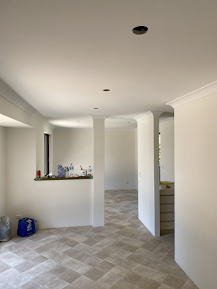Ceilings are often the unsung heroes of our homes, providing structural support and contributing to the overall aesthetic appeal of a room. However, like any other part of your home, ceilings can suffer from wear and tear, damage, or simply become outdated. Whether you're dealing with a leaky roof, cracks, or a desire for a new look, proper ceiling care is essential. This guide covers everything you need to know about ceiling repairs, maintenance, and replacement.
Common Ceiling Issues
-
Water Damage: One of the most common problems homeowners face is water damage. This can be caused by roof leaks, plumbing issues, or excessive humidity. Signs of water damage include discoloration, peeling paint, and sagging.
-
Cracks and Holes: Cracks can occur due to the natural settling of the house, temperature fluctuations, or structural issues. Small cracks can be cosmetic, but larger ones may indicate a serious problem.
-
Stains and Discoloration: Stains can result from water damage, smoke, or mold. These not only affect the appearance of your ceiling but can also be indicative of underlying issues.
-
Sagging Ceilings: Sagging can be caused by water damage, the age of the materials, or excessive weight from above (such as heavy insulation or waterlogged materials).
Ceiling Repairs
-
Fixing Water Damage: The first step is to identify and repair the source of the leak. Once the leak is fixed, damaged ceiling materials should be removed and replaced. Use a stain-blocking primer before repainting to prevent stains from bleeding through.
-
Repairing Cracks and Holes: Small cracks can be filled with a joint compound and sanded smooth. For larger cracks or holes, you may need to use a patch or replace a section of drywall. Ensure that any repairs blend seamlessly with the existing ceiling texture.
-
Dealing with Stains and Discoloration: After addressing the cause of the stain, clean the affected area and use a stain-blocking primer before repainting. For mold stains, use a mold-killing solution and ensure the area is properly ventilated.
-
Fixing Sagging Ceilings: Depending on the cause, you may need to reinforce the ceiling structure, replace damaged materials, or address the source of moisture. In severe cases, professional help may be required.
Ceiling Maintenance
-
Regular Inspections: Periodically check your ceiling for signs of damage, such as cracks, stains, or sagging. Early detection can prevent more serious issues.
-
Maintain Proper Ventilation: Ensure your home is well-ventilated to prevent moisture buildup, which can lead to mold growth and water damage.
-
Control Humidity: Use dehumidifiers in humid areas of your home to reduce the risk of moisture-related problems.
-
Clean Regularly: Dust and clean your ceiling to prevent the buildup of dirt and grime, which can affect the paint and overall appearance.
Ceiling Replacement
Sometimes, repairs and maintenance are not enough, and replacement becomes necessary. Here are some signs that it might be time to replace your ceiling:
-
Extensive Water Damage: If large areas of your ceiling are water-damaged, replacement may be more cost-effective than repair.
-
Structural Issues: Significant sagging or damage due to structural problems often requires a complete replacement.
-
Outdated Appearance: If your ceiling is outdated or doesn't match your desired aesthetic, replacing it can give your home a fresh, modern look.
-
Health Hazards: Ceilings with mold, asbestos, or other hazardous materials should be replaced to ensure the safety of your home.
Choosing the Right Materials
When replacing your ceiling, consider materials that suit your needs and style:
- Drywall: Common and versatile, ideal for most homes.
- Plaster: Durable and can create a smooth finish or intricate designs.
- Ceiling Tiles: Great for easy installation and access to plumbing or wiring.
- Wood Paneling: Adds a warm, natural look to your home.
- Metal Panels: Modern and durable, suitable for contemporary designs.
Conclusion
Maintaining, repairing, and, when necessary, replacing your ceiling is crucial for the safety, functionality, and aesthetic appeal of your home. Regular inspections and timely repairs can prevent minor issues from becoming major problems, while thoughtful replacements can rejuvenate your living space. By staying proactive and informed, you can ensure your ceiling remains in top condition for years to come.

